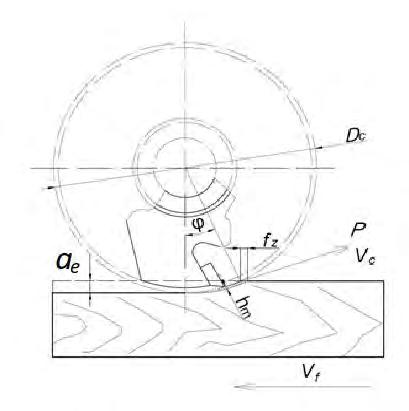
17 minute read
WOOD-BASED MATERIALS
ACTA FACULTATIS XYLOLOGIAE ZVOLEN, 61(1): 93−101, 2019 Zvolen, Technická univerzita vo Zvolene DOI: 10.17423/afx.2019.61.1.09
DETERMINATION OF THE CUTTING POWER DURING MILLING OF WOOD-BASED MATERIALS
Advertisement
Valentin Atanasov – Georgi Kovatchev
ABSTRACT
Results of milling of wood-based materials used in furniture production like plywood and medium-density fibreboard (MDF) are presented in the paper. The experiments were performed using the wood shaper with lower spindle position FD-3 located in a laboratory at the Department of Woodworking Machines, University of Forestry – Sofia., The input power to the cutting mechanism was reported by measuring device US301EM – Unisyst Engineering Ltd. and its software. Accordingly, a planned two-factor regression analysis was performed to determine the influence of feed speed and cutting area. Following the experiment, regression equations were developed. They can be used in the analytical determination of the influence of the factors considered on the target function – cutting power. The results show that cutting power of the plywood reaches significant values exceeding those of MDF and commonly used wood species studied in previous research carried out by the authors. Key words: MDF, plywood, milling, cutting power, power-energetic indicators.
INTRODUCTION
Composite wood-based materials such as plywood and MDF are widely used in modern furniture production, although they are relatively new materials. Based on their good physical-mechanical performance, they are used to make cabinet furniture, armchairs, beds, chairs, and others (SIMEONOVA 2015, JIVKOV et al. 2013). This wide application requires their participation in a variety of technological operations in the production of the listed furniture types. One of them is milling.
Milling machines with a lower spindle position have a significant application in furniture production, manufacture of doors, windows, etc. This is mainly due to their universality – i.e. they can be used for a variety of wood operations. It is necessary to determine the cutting power when designing them. On its base, the electric motor that is required to drive the cutting mechanism must be selected (FILIPOV 1979, VLASEV 2007).
In recent years, experimental studies that relate to the definition of power-energetic indicators in milling were conducted. They concern power, force, specific work of cutting and specific electricity consumption for widespread in furniture production wood species such as beech (Fagus sylvatica L.), white pine (Pinus sylvestris L.), meranti (Shorea leprosula) and koto (Pterygota macrocarpa) (GOCHEV et al. 2017, GOCHEV et al. 2018, KUBŠ et al. 2016, KRAUSS et al. 2016, ATANASOV,KOVATCHEV 2018). There are also studies for the milling of wood species, which are used for other purposes – poplar wood (Populus
tremula L.) (BARCÍK et al. 2008), moreover, for other machines such as circular saws (KOVÁČ,MIKLEŠ 2010, KOPECKY et al. 2014, ORLOWSKI, OCHRYMIUK 2017) and band saws (ATANASOV 2014, CHUCHALA, ORLOWSKI 2018). However, no results related to powerenergetic indicators of woodworking machines in processing of wood-based composite materials have been found in the literature. This is what determines the aim of this study: to conduct experimental research on the influence of key factors on cutting power in milling of widespread in furniture manufacturing materials such as plywood and MDF.
THEORETICAL BACKGROUND
Cutting forces occur in the interaction of wood with the cutting tool. These forces require a certain power to overcome them. It is called cutting power. In milling, these forces have a variable character because the thickness of the chip – when the cutting edge enters it is zero, and when it comes out it is maximum (when the feed direction is opposite to the cutting). In the theory, mostly based on past experiments conducted in the territory of the former Soviet republics, for the calculation of cutting power, some empirical formulas are used. By accepting the average values of the parameters involved, they can be simplified with practical purposes (BERSHADSKIY,TSVETKOVA 1975, IVANOVSKIY et al. 1972). One of them is
���� = ����������������, (1) where kc is the specific cutting resistance, N·m-2; ap – axial depth of cut (cutting width), m; ae – radial depth of cut, m; vf – feed speed, m.s
-1 .
Figure 1 shows a simplified scheme of the milling process showing the average tangential cutting force P, feed per tooth fz, angle range φ, average uncut chip thickness hm, uncut chip thickness h (working engagement), cutting diameter Dc, feed speed vf and cutting speed vc directions. The latter direction is overlapped with a direction of the cutting force.
Fig. 1 Scheme of the milling process with a groove cutter.
In the literature, the specific cutting energy ec is defined as an amount of work required to convert a cubic meter of wood into sawdust (GRIGOROV 1992), and its value is equal to
the specific cutting resistance kc which is commonly used in the industrial practice. Accordingly, it is noted that a number of factors can be influenced by, which can be assumed to have a direct effect on the cutting power. They are related to the physical and mechanical characteristics of the type of wood, its density, moisture content, temperature, etc. It is also noted that the kinematics of the process, the condition of the cutting tool, its linear and angular parameters, the type of cutting, etc., have an impact as well.
MATERIAL AND METHODS
The experimental studies were conducted by a wood shaper with a lower spindle position, model FD-3 (ZDM Plovdiv, Bulgaria). Some of its more important technical parameters are: power and resolutions of the electric motor (AC, asynchronous) – Nm = 3000 W and nm = 2880 min-1, power supply voltage Np.s.= 3 x 380 V/50 Hz and diameter of the spindle Dm = 30 mm. The cutting tool is a groove cutter with the following basic parameters – cutting diameter Dc = 140 mm, thickness of the cutting plates s = 12 mm, front angle of cutting γ = 20 ̊, angle of sharpening β = 58 ̊, number of cutting teeth z = 6 pcs, material for hard-alloy plates – HW, weight m = 0,910 kg. The cutting tool is brand new and used only to conduct experiments. This gives reason to assume that in this case the impact of cutting edge wear is minimal and does not affect the process. To drive the spindle a V-ribbed belt was used. With the respective gear ratio, at diameters of the pulleys D1 = 190 mm (drive pulley) and D2 = 90 mm (driven pulley),taking into account the sliding coefficient, ns ≈ 6045 min-1 spindle resolutions were obtained, hence, calculated cutting speed is vc = 44,3 m.s
-1 .
The experimental samples are MDF blanks with a length L = 1200 mm, width B = 60 mm, thickness δ ≈ 20 mm and plywood blanks (made of beech veneer and urea formaldehyde adhesive) with the same dimensions. The density of the blanks was calculated based on theirs weight and volume. The weight is measured by electronic scale RADWAG WLC 1/A2 (Poland). The volume was determined by measuring their dimensions with a caliper and measuring tape. The general view of some of them can be seen in Fig. 2.
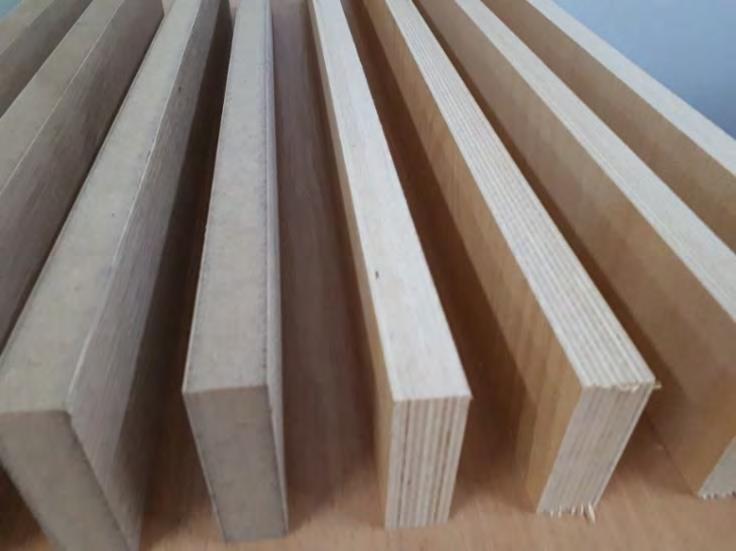
Fig. 2 Experimental samples of MDF and plywood.
In this study, the cutting power was determined experimentally. For this purpose, empirical equations such as formula 1 are not used. The cutting power is calculated by the formula 2. Previously, the efficiency coefficient of the cutting mechanism was determined (formula 3) (GOCHEV et al. 2017).
����������−���������� 100
)��, where Nidle is input power of the cutting mechanism in idle condition, W; Nload – input power of the cutting mechanism in load condition, W. �� = (1 − ����������)100. ���������� (2)
(3)
To measure the input power of the cutting mechanism in load and idle conditions, the device US301EM – Unisyst Ltd. (Bulgaria) was used. It allows measurement of active, reactive, full power, current, voltage, etc. – in phases and in general. Three current CNC® CURRENT TRANSFORMER and three voltage transformers UNITRAF AD Ltd. were used to connect it to the electrical network of the machine. The required configuration was made as well. Using specialized software from the manufacturer, the results are automatically imported into Microsoft Excel and their average value was found.
The cutting power Nc (Y) is determined by conducting a planned two-factor regression analysis. As factors (input parameters), the feed speed vf (X1) and the area of cutting were selected А (X2– it is obtained by multiplying the thickness of the cutting part of the tooth s –which is equal to the axial depth of cut ap (the width of the cut) and radial depth of cut ae –the depth of the groove). The levels of variation of the relevant factors are determined by conducting preliminary experimental experiments. Furthermore, they are the same as those used in previous experiments by the authors in longitudinal milling of solid wood. The reason for this is the ability to perform a comparative analysis between the values of milling of composite materials and solid wood – something which, due to the wide variation in experimental conditions, is difficult to accomplish with the part of the studies mentioned in Introduction. The levels of variation are X1 = 2, 6 and 10 m.min-1 , Х2 = 48, 96 and 144 mm2 . Figure 3 is a graphical representation of the cutting process by a part of the cutting mechanism and machined detail.

Fig. 3 Experimental scheme.
Table 1 shows the experimental matrix with the combination of factors in explicit and encoded form. In addition, some additional experiments have been performed, the levels of which correspond to the middle of the factor space Х1= 0 and Х2 = 0. Due to their large
volume, the steps for the computation of the regression analysis are not described in this study. They can be seen in the literature on mathematical modelling of technological objects VUCHKOV (1986). To obtain the regression equations that describe the relevant processes and their verification, QstatLab5 and Microsoft Excel software products were used.
Tab. 1 Experimental Matrix.
№
1. 2. 3. 4. 5. 6. 7. 8. 9.
X1 (vf)
+1 +1 –1 –1 0 0 +1 0 –1
vf, m.min-1 10 10 2 2 6 6 10 6 2 X2 (A)
+1 –1 +1 –1 0 +1 0 –1 0
A, mm2 144 48 144 48 96 144 96 48 96
RESULTS AND DISCUSSION
When calculating the density of the test samples were obtained values for MDFρmdf = 585 kg.m -3 and plywood ρpl = 735 kg.m -3. As can be seen from the values obtained, the density of plywood is 150 kg.m -3 higher than that of MDF.
The following regression equations were inferred from the processing of the obtained experimental results. After further calculations for the Fisher criteria and comparing it to the table value, it was proven that they are adequate and may be used for analysis of the respective process (factor levels are encoded: -1, 0, +1):
MDF
Ncmdf(Y) = 0.258+0.145vf+0.203A+0.048vf 2+0.022A2+0.122vfA; (4)
Plywood Ncpl(Y) = 0.965+0.399vf +0.593A-0.062vf 2 -0.074A2+0.258vfA. (5) As it can be seen from the equations, the regression coefficient for the two materials is higher in front of the factor A – the area of milling. This means that it has a greater impact on cutting power. It is also seen that this factor is more dominant in plywood A = 0.593. The trend of the influence of factors is similar in longitudinal milling of solid wood – white pine (Pinus sylvestris L.), meranti (Shorea leprosula) and koto (Pterygota macrocarpa).
Figure 4 graphically shows the results after solving the MDF equation – for the three considered areas of milling. It is noted that at the lowest feed speed level 2 m.min1, the power values for milling areas 44 and 96 mm2 are approximately the same. Even during the experimental tests themselves, it was clearly felt that the load on the electric motor was minimal. Subsequently, after reaching the feed rate of about 4 m.min-1, it is clearly evident that the curve corresponding to a 96 mm2 milling area begins to rise more intensively. The feed speed has the most insignificant impact at a level of milling area 48 mm2 – the difference between the values at vf = 2 m.min1 and vf = 10 m.min-1 is minimum – 0.18 kW. The highest value obtained at vf = 10 m.min1 and A = 144 mm2 is approximately 0.8 kW, which is higher than expected – bearing in mind the homogeneous structure of this material. It can be concluded that the cutting power at milling of MDF, at the maximum levels of the factors considered, is close to that obtained in the longitudinal milling of wood species such as meranti (Shorea leprosula ≈ 0.9 kW) and koto (Pterygota macrocarpa ≈ 0.8 kW) (ATANASOV,KOVATCHEV 2018). As a reason for this, the adhesive added to the preparation of medium density wood fiber boards can be mentioned. Its potential abrasive impact and
the likely increase in the wear of the teeth during the experiments themselves can be mentioned as well. However, it can be argued that this is unlikely. The reason is that in previous studies it was found that the cutting speed factor Vc had the lowest impact on target function and 6045 spindle revolutions were determined to be optimal (Gochev et al. 2017, Gochev et al. 2018). For this reason, in the present study it is not included. A two-factor experiment that does not require a large number of tests was carried out – i.e. the influence of wear on cutting edges may be ignored.
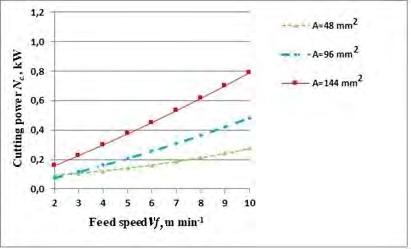
Fig. 4 Influence of feed speed on cutting power at various areas of MDF milling.
The influence of the feed speed in milling of plywood is represented graphically in Figure 5. It is also seen here that at the smallest milling area the difference between the first and the last value (2 and 10 m.min-1) is the lowest– i.e. for A = 48 mm2 the analysis is identical to that for MDF. It is also evident from the curves that only in the lowest levels of variation of the factors vf = 2 m.min-1 and A = 48 mm2 the results for the two materials differ minimally. Subsequently, they increased significantly, and in milling areas of 96 and 144 mm2, the calculated values and the resulting curves for plywood exceed those for MDF approximately three times over their entire length. In addition, when comparing the plywood with previous studies conducted for the same conditions, the significant dominance in cutting power was noted. This is clearly expressed at the highest levels of variation of factors where the power significantly exceeds that of longitudinal milling of solid wood like meranti (Shorea leprosula), koto (Pterygota macrocarpa), white pine (Pinus sylvestris L.) and even approximately 2 times greater than that of beech (Fagus sylvatica L.) (ATANASOV, KOVATCHEV 2018, GOCHEV et al. 2017, GOCHEV et al. 2018). The significant load was also felt during the tests – by changing the noise of the engine. The reason for this can be found in the greater amount of glue. Moreover, taking into account the technology for obtaining these materials, the cutting here can be regarded as a more complex and energy intensive, as opposed to clear longitudinal cutting of solid wood. It should also be noted that the material used is beech veneer, which has greater density and strength. This determines the plywood as a material whose cutting requires high power. For this reason, it is not advisable to process it under severe cutting modes when the electric motor of the cutting unit has a nominal power of 3 kW(overloading is only allowed for short periods of time). In this case, if it is impossible or impractical to use a more powerful machine, it is advisable to cut larger areas in several passes through the machine or at low feed rates.
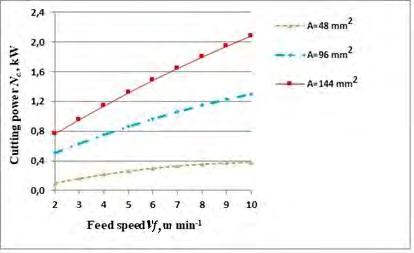
Fig. 5 Influence of feed speed on cutting power at various areas of plywood milling.
Figure 6 shows the effect of the more significant factor (A) on the cutting power at the highest feed rate (10 m.min-1) for both materials. From this figure, the trend that for each milling area the cutting power of the plywood is about 3 times greater than that of MDF is clearly visible.
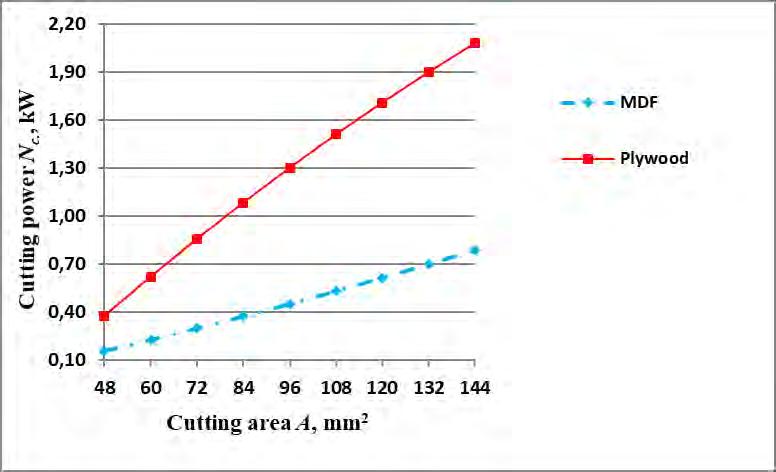
Fig. 6 Influence of milling area on cutting power in milling of MDF and plywood.
CONCLUSIONS
On the basis of the conducted experimental studies, the following more important conclusions and recommendations can be made: 1. Adequate regression equations that can be used to analyze the influence of feed speed and milling area on the cutting power of machining MDF and plywood were obtained. This power can be considered as average, since at this cutting speed each of the teeth of the tool have passed through the material processed about 100 times per second. For this reason, it was practically very difficult to determine the influence of the thickness of the chip – i.e. it is necessary to adopt an idealization of the cutting process. 2. When cutting plywood, the cutting power exceeds 2 kW at higher levels of variation of the factors considered. Such values exceed significantly those obtained under the same
conditions but in longitudinal milling of solid wood – white pine (Pinus sylvestris L.), beech (Fagus sylvatica L.), meranti (Shorea leprosula), koto (Pterygota macrocarpa) etc. 3. The cutting power during the processing of MDF, considering its homogeneous structure and a relatively low density, is approximately equal to that obtained with the aforementioned tropical wood species – meranti (Shorea leprosula), koto (Pterygota macrocarpa).
REFERENCES
ATANASOV, V. 2014. Izsledvane na operativnite pokazateli za mobilni khorizontalni lentovi trioni Disertatsiya na Ph.D, Sofia : Lesotekhnicheski universitet, 196 s. ATANASOV, V., KOVATCHEV, G. 2018. Determination of the cutting power in processing some deciduous wood species. In The 8th Conference on Hardwood Research and Utilisation in Europe –Sopron, 2018, 8: 53-55. ISBN 978-963-359-096-6. ISSN 2631-004X. BARCÍK, ST., PIVOLUSKOVÁ, E., KMINIAK, R. 2008. Effect of Technological Parameters and Wood Properties on Cutting Power in Plane Milling of Juvenile Poplar Wood. In Drvna industrija, 2008, 59(3): 107112. ISSN: 0012-6772. EISSN: 1847-1153. BERSHADSKY, A., TSVETKOVA, N. 1975. Rezka dereva. Minsk, 1975, 304 s. CHUCHALA, D., ORLOWSKI, K. 2018. Forecasting values of cutting power for the sawing process of impregnated pine wood on band sawing machine. In Mechanik. 2018, (89): 766768. DOI: 10.17814/mechanik.2018.8-9.128. FILIPOV,G. 1979. Mashini za proizvodstvo na mebeli i obzavezhdane. Sofia, 1979, 462 s. GOCHEV, ZH., VUKOV, G., VITCHEV, P., ATANASOV, V., KOVATCHEV, G. 2017. Modelirane i eksperimentalno izsledvane na protsesite pri nadlŭzhno frezovane na masivno dŭrvo. In Tema № 22, Sofia : NIS / LTU, 2017, 76 s. GOCHEV, ZH., VUKOV, G., ATANASOV, V., VICHEV, P., KOVACHEV, G. 2018. Study on the Power –Energetic Indicators of a Universal Milling Machine. In The VIII-th International Scientific and Technical Conference Innovations in Forest Industry and Engineering Design. Sofia, 2018, 1: 1824. ISSN 1314-6149. e-ISSN 2367-6663. GRIGOROV, P. 1992. Ryazane na dŭrvo. Zemizdat. Sofia, 1992, 319 s. IVANOVSKY, E., VASILEVSKAYA, P., LAUTIER, M. 1972. Novyye issledovaniya lesozagotovok. In Lesnaya promyshlennost', 1972, 128 s. JIVKOV, V., SIMEONOVA, R., MARINOVA, A. 2013. Influence оf the Veneer Quality and Load Direction on the Strength Properties of Beech Plywood as Structural Material for Furniture. In Innovation in Woodworking Industry and Engineering Design, 2013, 1: 86-92. ISSN 1314-6149. eISSN 2367-6663. KOPECKY,Z.,HLASKOVA,L.,ORŁOWSKI,K. 2014. An Innovative Approach to Prediction Energetic Effects of Wood Cutting Process with Circular-Saw Blades. In Wood research, 2014, 59(5): 827834. ISSN: 1336-4561. KOVÁČ,J.,MIKLEŠ,M. 2010. Research on Individual Parameters for Cutting Power of Woodcutting Process by Circular Saws. In Journal of forest science, 2010, 56 (6): 271–277. ISSN 1212-4834 (Print). ISSN 1805-935X (On-line). KRAUSS,А.,PIERNIK,M,PINKOWSKI,G.2016.Cutting Power during Milling of Thermally Modified Pine Wood. In Drvna industrija, 2016, 67 (3): 215-222. ISSN: 0012-6772. EISSN: 1847-1153. KUBŠ, J., GAFF, M., BARCÍK, ST. 2016. Factors Affecting the Consumption of Energy during the Milling of Thermally Modified and Unmodified Beech Wood. In Bio Resources, 2016, 11(1): 736747. ISSN: 1930-2126. ORLOWSKI,K.,OCHRYMIUK,T.2017.A newly-developed model for predicting cutting power during wood sawing with circular saw blades. In Maderas-ciencia y tecnologia. 19(2): 149162. DOI: 10.4067/S0718-221X2017005000013 SIMEONOVA, R. 2015. Kharakteristiki na yakostta i deformatsiyata na ŭglovite sŭedineniya na strukturni elementi, izraboteni ot shperplat. Disertatsiya na Ph.D, Sofia : Lesotekhnicheski universitet, 166 s.
VLASEV, V. 2007. Uprazhnenie za uprazhnyavane na dŭrvoobrabotvashti mashini. Sofia : Lesotekhnicheski universitet,78 s. VUCHKOV, I., STOYANOV, S. 1986. Matematichesko modelirane i optimizatsiya na tekhnologichni obekti. Sofia : Tekhnika na Dŭrzhavnoto izdatelstvo. 341 s.
ACKNOWLEDGEMENTS
This document was supported by the National Program "Young Scientists and Postdoctoral Students", Institution - University of Forestry, Faculty of Forest Industry (FFI).
AUTHORS’ ADDRESSES
Chief Assist. Prof. Valentin Atanasov, PhD, Assist. Prof. Georgi Kovatchev, PhD, University of Forestry Faculty of Forest Industry Kliment Ohridski Blvd. 10, 1797 Sofia Bulgaria vatanasov_2000@ltu.bg g.kovatchev@gmail.com










